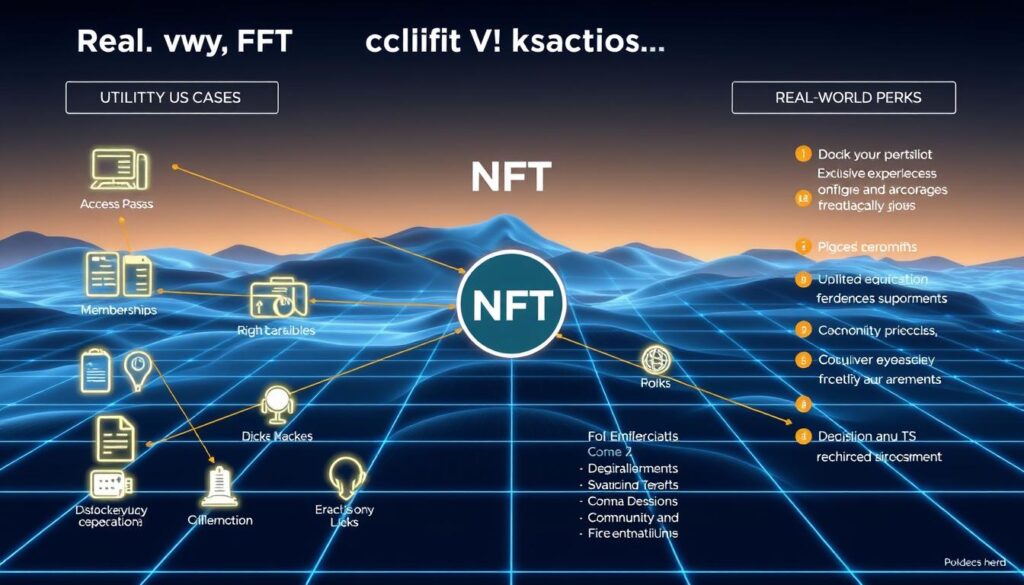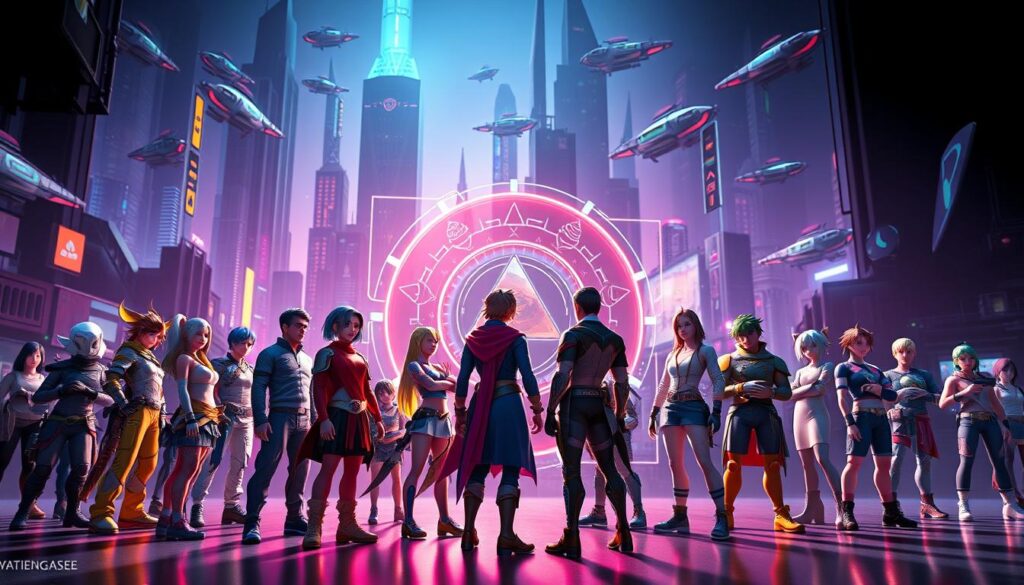Now Reading: Utility NFT Projects with Real World Benefits Explained
- 01
Utility NFT Projects with Real World Benefits Explained
Utility NFT Projects with Real World Benefits Explained

The digital collectibles space is evolving rapidly, with creators and collectors alike shifting focus toward tokens that deliver more than artistic appeal. Modern blockchain innovations now prioritize tangible value, transforming static images into dynamic tools for engagement. This movement merges virtual ownership with physical-world perks, creating assets that work harder for their holders.
These next-generation digital tokens unlock experiences previously unimaginable in Web3. Holders gain entry to private events, limited-edition merchandise, or even voting power in community decisions. Some designs connect directly to physical products, blurring the line between online ownership and real-life application.
The resurgence of interest stems from practical applications that extend beyond speculation. Creators now build ecosystems where participation rewards users through revenue-sharing models or exclusive access tiers. This approach turns digital collectibles into keys that open doors across industries – from entertainment to retail.
Key Takeaways
- Modern digital tokens prioritize functional advantages over pure collectibility
- Holders access premium experiences like VIP events and product drops
- Blockchain technology enables verifiable ownership of unique perks
- Innovative models connect virtual assets to physical goods and services
- Community governance features empower token holders with decision-making rights
- Revenue-sharing structures create ongoing value for participants
Understanding Utility NFTs: Unveiling Their Real World and Digital Benefits
Beyond digital art, blockchain tokens now serve as gateways to experiences and privileges that extend into everyday life. These dynamic assets prioritize functional advantages, connecting virtual ownership to physical rewards. Their value stems from active use rather than passive collection.

Defining Utility Tokens and Their Core Features
Utility tokens differ from standard digital collectibles through built-in functionality. Smart contracts enable automatic perk distribution, from concert tickets to voting rights. Three key features define them:
| Feature | Traditional Collectibles | Utility Tokens |
|---|---|---|
| Primary Purpose | Artistic display | Access & engagement |
| Value Driver | Market speculation | Ongoing benefits |
| Technology Use | Basic ownership tracking | Automated smart contracts |
Measurable Value vs Market Hype
Unlike speculative assets, utility tokens provide concrete advantages unaffected by price swings. A music festival pass token grants entry regardless of its resale value. Creators increasingly use these tokens for:
- Loyalty rewards programs
- Community governance systems
- Cross-platform interoperability
This shift transforms holders into active participants rather than passive investors. Digital ownership becomes a tool for unlocking experiences, not just storing JPEGs.
Exploring Utility NFT Projects with Real World Benefits
The next wave of blockchain innovation focuses on assets that offer both digital and real-life value. Over 23 million items compete for attention on OpenSea, but tokens delivering concrete advantages rise above the noise. Two standout examples demonstrate how virtual ownership unlocks experiences beyond screen-based interactions.

Pioneering Models for Lasting Engagement
World of Freight transforms racing enthusiasts into stakeholders through its vehicle customization ecosystem. Owners of racing machine tokens automatically earn $WOF credits for upgrades – whether enhancing terrestrial trucks or modifying spacecraft. This play-to-earn model creates constant incentives while expanding gameplay possibilities.
Metakey’s Genesis Editions prove single tokens can open doors across platforms. Holders gain early character access in gaming worlds, exclusive merchandise discounts, and surprise token distributions. One digital key works across seven blockchain environments, making it a universal access pass for Web3 explorers.
| Feature | World of Freight | Metakey |
|---|---|---|
| Core Offering | Customizable racing assets | Cross-platform access key |
| Reward System | Passive token generation | Multi-chain airdrops |
| Community Benefit | In-game governance rights | Partner platform discounts |
These models succeed by blending instant gratification with future potential. Immediate perks like cosmetic upgrades keep users engaged, while roadmap features like inter-game compatibility promise expanding value. The balance creates loyal communities invested in each project’s growth.
The Role of Blockchain Technology and Smart Contracts in NFT Utility
Digital ownership gains new dimensions through blockchain’s unchangeable ledger system. This technology creates tamper-proof records for every transaction, ensuring each token’s history remains transparent. Holders can verify authenticity instantly, eliminating doubts about an asset’s origins.

How Smart Contracts Automate Special Features
Self-executing code transforms static tokens into dynamic tools. When predefined conditions meet, these digital agreements activate perks like concert tickets or merchandise drops. A music platform might automatically send unreleased tracks to holders after 90 days of ownership.
Three core mechanisms power this automation:
| Feature | Traditional Systems | Blockchain Solution |
|---|---|---|
| Ownership Tracking | Manual verification | Decentralized ledger |
| Benefit Distribution | Third-party handling | Code-triggered actions |
| Upgrade Capability | Limited modifications | Programmable updates |
This approach removes middlemen from reward systems. Artists can set rules where 10% of secondary sales flow back to original creators through automated splits. Communities vote on feature changes directly through token-gated portals.
Upgradable contracts let developers add features without disrupting existing perks. A fitness app token might gain nutrition tracking years after launch while preserving original workout rewards. This flexibility future-proofs digital assets as markets evolve.
NFT Utility in Gaming and Virtual Worlds
Digital gaming economies are undergoing a radical transformation through blockchain-based ownership models. Players now wield true control over their virtual possessions, breaking free from centralized platforms that historically restricted item transfers. This shift empowers gamers to monetize achievements and build portable inventories across multiple titles.

Interoperability and In-Game Asset Ownership
Cross-platform compatibility reshapes how players interact with digital items. A rare sword earned in one fantasy game could become tradable armor in another universe. Axie Infinity demonstrates this through its creature tokens – battle-tested pets retain value when moving between gaming ecosystems.
Three key advantages emerge:
- Persistent item histories stored on blockchain
- Secondary market trading without developer fees
- Player-driven economies replacing corporate-controlled systems
Revolutionizing Virtual Real Estate and Digital Economies
Blockchain land parcels create new revenue streams for digital landowners. Decentraland users monetize virtual properties through advertising spaces and event hosting. A single plot recently sold for $2.4 million, demonstrating faith in metaverse commerce.
| Traditional Gaming | NFT-Driven Worlds |
|---|---|
| Centralized item storage | Cross-game asset portability |
| Developer-controlled markets | Player-to-player trading |
| Temporary achievements | Permanent ownership records |
Illuvium’s upcoming RPG expands these concepts by letting players export earned characters into other compatible titles. This interoperability creates lasting value for time invested in gaming ecosystems.
NFTs as Passes: Event Tickets, Exclusive Access, and Membership Tokens
Event organizers are reimagining ticketing systems through blockchain-based solutions that combat fraud while enhancing fan experiences. These digital passes merge instant verification with lasting collectibility, creating assets that serve multiple purposes beyond simple entry.
Unlocking VIP Access and Exclusive Events
Blockchain tickets eliminate duplicate sales and scalping through unique ownership records. Coachella’s Keys Collection demonstrates this potential – ten lifetime passes sold for $1.5 million, granting permanent festival access plus metaverse experiences. Venues now scan digital wallets instead of paper tickets, streamlining entry while preventing counterfeiting.
Enhanced perks create layered value for holders. A single token might include:
- Priority seating at live concerts
- Meet-and-greet opportunities
- Exclusive merchandise unlocks
Digital Memberships and Community Perks
Persistent blockchain memberships foster ongoing engagement through tiered rewards systems. Holders gain access to private Discord channels, early product releases, and voting rights for future events. These tokens often appreciate as communities grow, creating incentives for long-term participation.
| Traditional Membership | NFT-Based Access |
|---|---|
| Plastic cards | Verifiable digital assets |
| Centralized control | Decentralized ownership |
| Limited benefits | Expandable rewards |
Sports teams and artists now issue seasonal passes as digital collectibles. These tokens commemorate specific tours or seasons while granting recurring privileges across multiple events.
Bridging Digital and Physical Worlds with NFT Utility
Tokens now anchor virtual assets to tangible counterparts through blockchain’s unique capabilities. A sneaker brand might pair limited kicks with digital certificates that track every owner change. This fusion lets collectors verify rare items instantly while preserving their history.
Luxury goods gain new protection against counterfeits through embedded authentication systems. Wine producers attach tokens to premium bottles, storing vineyard details and aging records on-chain. Resellers scan QR codes to confirm authenticity, while buyers access full provenance histories.
Three innovative methods strengthen these connections:
- Smart contracts trigger physical rewards after ownership milestones
- Scannable tags update blockchain records during product transfers
- Dynamic tokens unlock location-specific experiences or merchandise
Fashion houses experiment with hybrid collectibles where digital wearables influence physical designs. Token holders vote on upcoming clothing lines through decentralized apps. Winning styles get produced as limited runs, with token owners receiving first-access privileges.
This integration reshapes consumer relationships with possessions. Assets gain layered value through upgradable features and cross-dimensional perks. A motorcycle token might offer virtual race entries alongside discounted maintenance plans at dealerships.
As bridges between realms strengthen, traditional industries adopt blockchain solutions for authentication and engagement. The result? Items that serve dual purposes as both functional products and evolving digital assets.
Integrating Physical Product Benefits with NFT Ownership
Luxury brands are redefining exclusivity by merging blockchain assets with high-end craftsmanship. Tiffany & Co.’s NFTiffs collection demonstrates this shift – 250 tokens sold at $50,000 each in minutes, converting digital CryptoPunk art into gemstone pendants. This hybrid approach creates dual-value items, where ownership unlocks both virtual prestige and physical artistry.
Authenticity, Provenance, and Real-World Redemption
Blockchain’s immutable records combat counterfeiting in luxury markets. Each NFTiff pendant carries a digital certificate tracking its creation journey – from diamond sourcing to artisan signatures. Buyers verify authenticity through smart contracts, ensuring their physical assets match on-chain data.
Redemption models now offer tiered benefits beyond one-time exchanges. Token holders might access:
- Annual jewelry customization sessions
- Priority reservations for future collections
- Exclusive previews of designer collaborations
| Feature | Traditional Luxury | NFT-Enhanced |
|---|---|---|
| Verification Process | Paper certificates | Blockchain scans |
| Ownership Tracking | Manual registry updates | Automatic ledger entries |
| Perks System | Fixed benefits | Upgradable rewards |
Creators leverage this fusion to build lasting communities. Physical redemption options turn casual buyers into brand ambassadors. A fashion house’s token might evolve from store discounts to front-row show access as ownership duration increases.
NFTs in DeFi: Financial Instruments and Revenue Sharing Models
Blockchain-based ownership models are merging with decentralized finance, creating new opportunities for digital asset holders. These hybrid systems transform collectibles into active financial tools, generating passive income streams while maintaining ownership rights. Platforms now enable token holders to participate in profit-sharing arrangements previously reserved for institutional investors.
Staking, Collateral, and Yield Generation
Digital assets gain financial utility through programmable earning mechanisms. Owners stake tokens to earn interest rates averaging 5-15% APY across leading platforms. Some ecosystems accept high-value items as loan collateral, unlocking liquidity without selling prized possessions.
Yield farming strategies now incorporate rare digital assets. A single token might generate revenue through:
- Platform fee distributions
- Governance participation rewards
- Automated royalty splits
Decentralized Finance Integration through NFTs
Smart contracts bridge collectibles with lending protocols and liquidity pools. A recent innovation lets users fractionalize ownership of premium tokens, democratizing access to high-value assets. These systems automatically distribute earnings to holders’ wallets, creating transparent revenue streams.
Leading ecosystems combine digital ownership with traditional financial features. Tokenized memberships now offer dividend-like payments based on platform growth, aligning holder incentives with project success.















